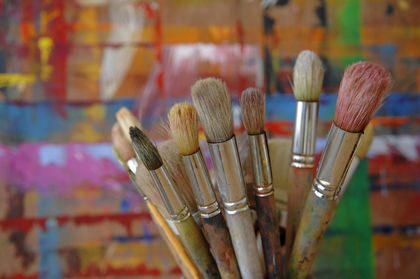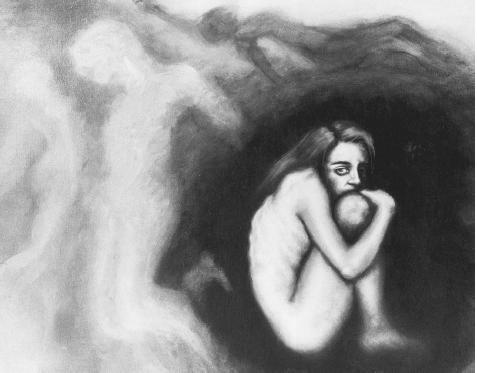Creative therapies

Definition
Creative therapy refers to a group of techniques that are expressive and creative in nature. The aim of creative therapies is to help clients find a form of expression beyond words or traditional therapy, such as cognitive or psychotherapy . Therefore, the scope of creative therapy is as limitless as the imagination in finding appropriate modes of expression. The most commonly used and professionally supported approaches include art therapy, writing, sand play, clay, movement therapy, psychodrama, role play, and music therapy.
Purpose
Creative therapy includes techniques that can be used for self-expression and personal growth when the client is unable to participate in traditional "talk therapy," or when that approach has become ineffective. Appropriate clients include children, individuals who are unable to speak due to stroke or dementia , or people who are dealing with clinical issues that are hidden within the subconscious, beyond the reach of language. The latter often occurs when the focus is on trauma or abuse that may have occurred before the client was able to speak, or in families where there is a strict code against talking about feelings or "negative" things. Creative therapy is also effective when used to explore fears around medical issues, such as cancer or HIV.
Precautions
Caution is indicated when strong emotions become overwhelming, thus debilitating the client. Possible indications for caution include the presence of flashbacks, panic attacks, recently revealed trauma or abuse, and vivid and realistic nightmares. Other indications for caution include individual characteristics, such as a tendency toward overly emotional responses, difficulty managing change or surprises, and poor coping skills. Therapists should also take care with patients with psychosis or borderline personality disorder .
Description
Visually expressive forms of creative therapy include drawing, painting, and modeling with clay. The goal is to provide a medium for expression that bypasses

Movement and music therapies are often used in conjunction with relaxation approaches. Movement therapy involves dance and the interpretation of feelings or thoughts into movement, and is often set to music. For teens in particular, music and movement are often healthy releases for stress and emotions. These therapies can also help people develop appropriate coping skills. Movement and music may be used in nursing homes, gym class, residential treatment centers, a therapist's office, or a home.
Journaling techniques have been studied extensively regarding their health benefits, both physical and emotional. Its application is broad and it can be used in various therapeutic approaches. Journaling can be used on a regular basis for stress relief by writing down whatever comes to mind, or it can be used for specific problem areas, such as focusing attention on goals or on unresolved feelings of grief or anger. In journaling, it seems to be more important to focus on emotional aspects, rather than using it to simply record daily events.
Other techniques include sand play, pet therapy, play therapy , and horticulture therapy. Sand play is a specialized form of play therapy in which sand is used to form designs or set up stories using play figures. Play therapy is an approach used with children, and is quite extensive in background theory and application. It is a psychological therapy in which the child plays in the therapist's presence. The therapist then uses a child's fantasies and the symbolic meanings of his or her play as a medium for understanding and communicating with the child. Pet therapy and horticulture therapy are often used in hospitals and residential treatment centers. Although these therapies are not expressive in the same way as other approaches, they offer a different experience for the individuals participating in them—helping people feel a sense of joy, connection, or accomplishment that may be missing from their lives.
Preparation
Little preparation is needed for the visually expressive forms. Drawing is often used in a first session with young children. When used with adults, drawing or painting is often helpful, especially at a time of impasse when "talk therapy" is not effective, or when focusing on more emotional aspects of the therapeutic work.
Role-playing requires the review of specific family roles to determine goals for the work. If the family work is focused on communication, each member may be asked to adopt the role of another family member to clarify their perceptions of current roles for themselves and the other family members. The purpose of adopting these roles is to gain insight and understanding about the other person's perspective in terms of their thoughts, feelings, and actions. Taking on the role of another helps to build empathy and provide a mechanism for personal growth and change.
A genogram or diagram of family members is some times helpful as a guide in identifying specific roles and directing the drama.
Aftercare
For most of the creative therapy techniques, aftercare will largely be maintained by the individual client, unless the individual is participating in a support group or ongoing therapy. One advantage of creative therapy is the ease of implementation. Little special equipment is needed, and many of the techniques easily lend themselves to use in the home. If an individual is participating in a support group or individual therapy following a hospitalization , the techniques can be maintained as part of those activities.

Risks
Risks occur when the client is exposed to intense emotional material or memories before the necessary preparatory work has been completed in therapy. Such negative reactions may include a psychotic break, or a need for hospitalization, although this is a rare occurrence.
A more likely risk is that of altering existing family relationships. Working through certain issues surrounding trauma or abuse may alter the participant's feelings or thoughts about significant people in his or her life. Conflicted feelings about these individuals may arise as recognition of certain patterns or behavior become apparent to the client. The increased awareness and insight may make it impossible for the client to continue some relationships. The resulting conflict may be uncomfortable for the client.
Normal results
Typical results include increased awareness, the release of suppressed emotions, a general lifting of depressive feelings, increased energy, and the resolution of internal conflict. Ongoing health benefits, such as lowered blood pressure, may result from decreased stress and improved coping skills. A greater sense of self-acceptance and decreased agitation are often experienced by clients.
Abnormal results
Unusual results include increasingly intense feelings of agitation and stress. For some individuals, the techniques may appear to have no benefits. It is recommended that these individuals seek clinical help.
See also Support groups ; Grief counseling
Resources
BOOKS
Epston, D. and White, M. Narrative Means to a Therapeutic End. New York, NY: Norton, W. W. and Company, 1990.
Hobday, A. and K. Ollier. Creative Therapy with Children & Adolescents. Atascadero, CA: Impact Publishers, 1999.
Kaduson, H. G. and C. E. Schaefer, eds. Short-term Play Therapy for Children. New York, NY: The Guilford Press, 2000.
Rubin, J. A., ed. Approaches to art therapy: Theory and technique. 2nd edition. Philadelphia, PA: Brunner-Routledge, 2001.
PERIODICALS
Harvey, S. "Dynamic play therapy: An integrative expressive arts approach to family therapy of young children." Arts in Psychotherapy 17, no. 3 (Fall 1990): 239-246.
Nicholson, K. "Weaving a circle: A relaxation program using imagery and music." Journal of Palliative Care 17, no. 3 (Fall 2001): 173-176.
Zammit, C. "The art of healing: A journey through cancer. Implications for art therapy." Art Therapy 18 no. 1 (2001): 27-36.
ORGANIZATIONS
American Art Therapy Association, Inc. 1202 Allanson Rd., Mundelein, IL 60060. (888) 290-0878). <www.arttherapy.org> .
OTHER
Arts in Therapy Network. <www.artsintherapy.com> .
Deanna Pledge, Ph.D.
Comment about this article, ask questions, or add new information about this topic: